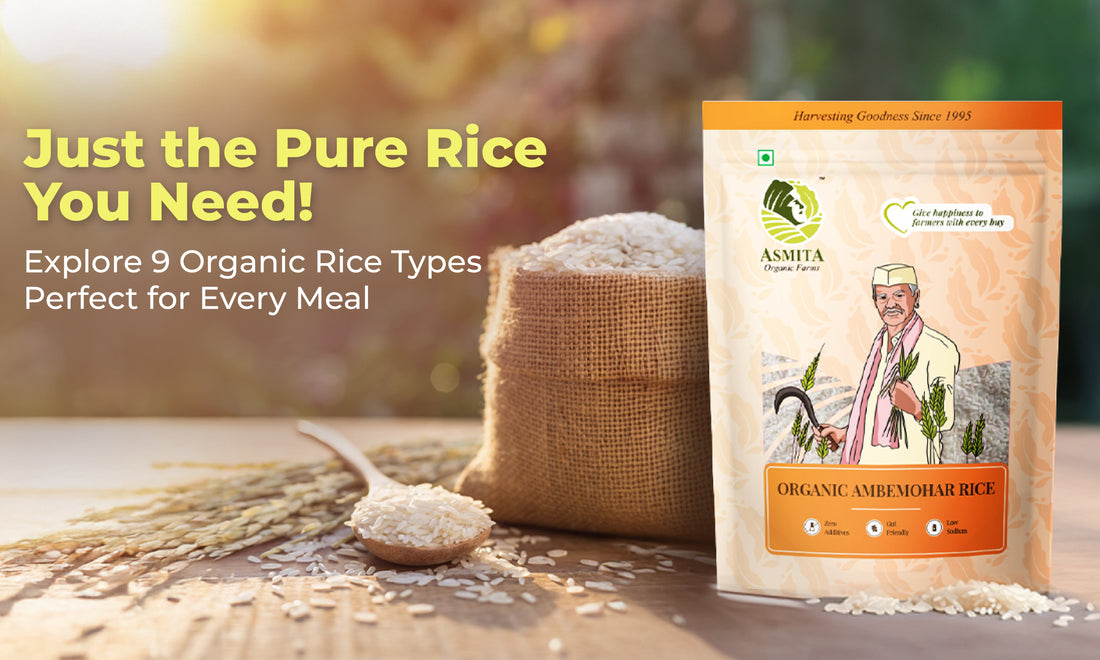9 Types of Healthy Rice in India You Should Know
Info Organic 5 min read
Rice has been a part of Indian households for centuries, not just for daily meals but also for cultural practices and traditional dishes. India is the world's second-largest rice producer, and rice is the backbone of its diverse cuisine. It is a rice treasure trove with over 6000 rice varieties grown in the country. From fragrant Basmati to Black Rice, each variety of rice in India has a rich texture, taste, and numerous health benefits.
Indian rice varieties are celebrated not just for their taste but also for their nutritional value. Many of them have low glycemic indexes and are perfect for diabetics. In this blog, we will explore the 9 healthiest rice types in India, their health benefits, and popular recipes to encourage you to include them in your diet.
Whether in savoury dishes or desserts, this list of rice varieties (all excellent harvests) can be a wholesome addition to any meal. Learn more about the country’s grains here.
Table Of Contents:
- 9 Healthy Rice Varieties in India
- Which Types of Indian Rice Are Good for Diabetes?
- Healthy Indian Rice Variety and Its Popular Recipes
- Bottom Line
9 Healthy Rice Varieties in India
As more and more people look for healthier options, some rice types stand out for their nutritional value and health benefits. Whether you are managing a specific health condition or just looking to explore culinary diversity, there are various varieties of high-quality rice to support that.
Here is a detailed look at the nine healthiest types of rice in India, summarising their characteristics, benefits, and uses:
Rice Variety |
Characteristics |
Nutritional Benefits |
Uses |
|
Deep purple-black grains |
Packed with antioxidants; reduces oxidative stress |
Desserts, side dishes |
|
|
Nutty flavour, reddish colour |
Contains anthocyanins; supports immunity and heart health |
Curries, porridge |
|
|
Brown rice |
Whole grain with bran intact |
High in fibre; supports digestion, heart health, and cholesterol control |
Stir fries, rice bowls |
|
Sticky, short-grained crop |
High nutritional content; boosts immunity |
Maharashtra dishes, puddings |
|
|
Medium-grain, light texture |
Low calorie; ideal for daily consumption |
Plain rice, idli batter |
|
|
Fragrant, delicate aroma; soft, melt-in-the-mouth texture |
Grown sustainably; retains natural goodness; rich in traditional nutrients |
Kheer, festive pulao, aromatic steamed rice |
|
|
Short-grain, polished rice with a soft texture |
Rich in energy; easily digestible; a staple food for quick energy |
South Indian meals like rasam rice, curd rice |
|
|
Basmati rice |
Long, fragrant grains |
Low glycemic index; rich in carbohydrates; suitable for diabetes |
Biryani, pulao |
|
Gobindobhog rice |
Short, sticky grains |
High in energy; ideal for digestion |
Bengali sweet dishes, khichdi |
Which Types of Indian Rice Are Good for Diabetes?
For those managing diabetes, choosing rice with a lower glycemic index (GI) and higher fiber content can help regulate blood sugar levels. The following table highlights the Indian rice types that are suitable for diabetes management:
Rice variety |
Glycemic Index (GI) |
Benefits for Diabetes |
|
Black rice |
Low to medium (42-52) |
Antioxidants improve insulin sensitivity. |
|
Red rice |
Medium (55-65) |
Anthocyanins reduce inflammation and improve glucose metabolism. |
|
Brown rice |
Low (50-55) |
High fiber content slows glucose absorption. |
|
Basmati rice |
Medium (50-58) |
Low GI; provides steady energy without spiking blood sugar. |
Here are some quick tips for diabetics:
- Pair rice with protein-rich foods like lentils or lean meats to control blood sugar.
- Use portion control and choose boiled rice over fried or processed ones.
AsmitA Organic Farms offers organic rice in various options. The farm’s rice is carefully grown using sustainable, pesticide-free methods to maintain nutritional values and natural taste.
Kolam White Rice and other regional options are also available, all grown without harmful chemicals. The focus on organic farming ensures each organic grain is good for your health and the environment. AsmitA goes the extra step to ensure healthy, chemical-free rice.

Here’s how AsmitA Organic Farms fits into healthy, sustainable rice farming:
Pesticide-free farming:
We ensure to follow sustainable farming methods and source rice grains that are grown without any harmful chemicals.
Nutritional values:
Our sourced rice is grown to retain its nutritional values. As a result, you get grains that are not only wholesome but packed with essential nutrients for your well-being.
Wide range of rice:
Red rice and other regional options are grown with utmost care and quality.
Organic focus:
All rice is grown organically, and no pesticides or synthetic fertilizers are used. It is safe for health-conscious people.
Quality:
AsmitA Organic Farms offers farm-fresh rice. Every grain is carefully cultivated to be pure, nourishing, and safe.
Healthy Indian Rice Variety and Its Popular Recipes
Indian rice varieties are as many as the country’s cultures, with a plethora of flavours, textures, and nutrients. From the fragrant Ambemohar rice to the earthy black rice, each variety brings something to the table.

Here are some of the healthiest rice varieties in India and how to use them in healthy recipes:
|
Rice Variety |
Recipes |
|
Brown Rice |
Soak brown rice for 30 minutes before cooking to reduce cooking time and texture. Rice is a whole grain, with bran and germ intact, which adds fibre, vitamins, and minerals. It is also an excellent source of magnesium, which supports muscle function and enhances overall health. Brown rice biryani, a healthier version of biryani, is high in fibre and complex carbohydrates. Stir-fried brown rice with mixed vegetables is a simple and nourishing dish. For a comfort food classic, brown rice khichdi with moong dal is a balanced meal. |
|
Basmati Rice |
Rinse basmati rice well to remove excess starch and get fluffy grains. Basmati rice is known for its long and slender grains and fragrance. It is primarily carbohydrate-dense but is considered to have a lower glycemic index than other rice varieties. It’s a healthier option for diabetics. Chicken biryani, a favourite among rice lovers, uses Basmati rice to soak up the flavours of marinated chicken and spices. Paneer pulao or vegetable fried rice are vegetarian options that are equally flavourful. Basmati rice is light and fluffy, perfect for these dishes. |
|
Red Rice |
Cook red rice in a pressure cooker for a softer texture, as it takes longer to cook than white rice. Red rice is rich in antioxidants, particularly anthocyanins, which give it a reddish-brown colour. It is also high in fibre and iron, which are beneficial for digestive health and help combat iron deficiency. Kerala-style red rice with coconut curry brings out the earthy flavour of the rice. On the other hand, red rice upma is a healthy breakfast option. Savour red rice, vegetables, and spices for a wholesome start to the day. |
|
Black Rice |
Soak overnight for faster cooking and to unlock its rich flavour. Often referred to as "forbidden rice," black rice is packed with anthocyanins, the same antioxidant compounds found in blueberries and other dark fruits. This variety is also gluten-free and has a rich, nutty flavour. Black rice pudding, or kheer, is a popular dessert that uses the rice's deep colour and earthy taste to create a visually stunning and flavorful dish. Additionally, black rice salads with fresh veggies can make for a nutrient-packed, gluten-free meal. |
|
Gobindobhog Rice |
Use this short-grain rice for creamy dishes like payesh as it is sticky. Gobindobhog rice is used in Bengali cuisine and is known for its delicate, slightly sticky texture. It is a great match for desserts as it absorbs flavours well. Bengali khichuri, a rice and lentil dish, is served with vegetables or chutneys. Payesh, a Bengali rice pudding, is another favourite that makes proper use of the creamy texture of Gobindobhog rice. |
|
Sona Masoori Rice |
Use this for soft-texture recipes. Sona Masoori is a medium-grain rice variety in India's southern region. Low in starch, it becomes light and fluffy when cooked. It is a good source of carbohydrates and is ideal for weight management as it has a low glycemic index. Lemon rice is a refreshing dish made by mixing cooked rice with lemon juice and tempered spices. Tamarind rice with tamarind paste and spices is another South Indian favourite. Sona Masoori is also used to make dosa batter for crispy pancakes. |
|
Indrayani Rice |
Its sticky texture makes it ideal for thick recipes. Indrayani is a small aromatic rice from Maharashtra. Maharashtrian khichdi with Indrayani rice is a comfort food that is easy to digest and nutritious. The rice pudding made from this variety is thick and creamy and is a perfect dessert to go with the natural aroma of the rice. |
|
Ambemohar Rice |
A short-grain aromatic rice from Maharashtra, Ambemohar translates to "mango blossom." Its delicate aroma and soft texture make it ideal for festive dishes, desserts, and traditional recipes like pulao or kheer. This rice is prized for its melt-in-the-mouth quality and ability to retain its natural fragrance after cooking. |
|
Kollam White Rice |
Kollam rice is a short-grain, polished white rice known for its light, fluffy texture. Popular in South Indian cuisine, it pairs perfectly with rasam, sambar, and curd-based dishes. Easy to cook and digest, Kollam rice is a staple for simple yet flavourful meals, making it a versatile choice for everyday use. |
Bottom Line

Rice isn’t just a staple but the heart of India’s agricultural heritage and culinary richness. At AsmitA Organic Farms, we celebrate this diversity by offering different varieties of rice that cater to both taste and health.
From the fiber-rich goodness of brown rice to the antioxidant-packed benefits of black rice, each type brings something unique to your plate. Choosing organic rice ensures not just better nutrition but also a sustainable choice for the planet.
So, why settle for the ordinary? Explore our wide range of different kinds of rice in India—all organic. Experience the true essence of Indian rice, one meal at a time.




